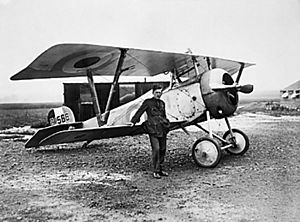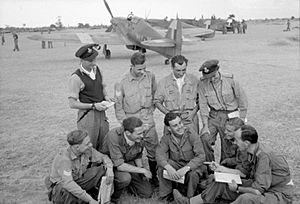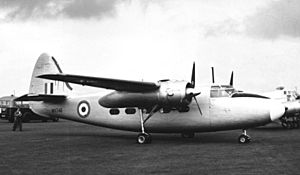No. 60 Squadron RAF facts for kids
Quick facts for kids No. 60 Squadron RAF |
|
|---|---|
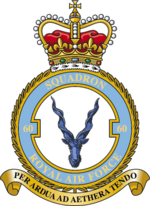
Squadron badge
|
|
| Active |
|
| Country | |
| Branch | |
| Type | Flying training squadron |
| Role | Advanced helicopter flying training |
| Part of | 9 Regiment, Army Air Corps |
| Home station | RAF Shawbury |
| Motto(s) | Per ardua ad aethera tendo (Latin for 'I strive through difficulties to the sky') |
| Aircraft | Airbus H135 Juno HT1 |
| Battle honours |
|
| Commanders | |
| Current commander |
Squadron Leader Nick Summers (August 2020 – present) |
| Insignia | |
| Squadron badge heraldry | A markhor's head, commemorating many years of service in North-West India, the markhor being a mountain goat frequenting the Khyber Pass. Approved by King George VI in December 1937. |
| Squadron codes | AD (Apr 1939 – Sep 1939) MU (Sep 1934 – Feb 1942, Aug 1943 – Oct 1946) A–Z (Wessex) |
| Post-1950 squadron roundel | |
No. 60 Squadron is a special part of the Royal Air Force (RAF). It was started way back in 1916 in a place called Gosport. Today, it's part of the No. 1 Flying Training School. This school is based at RAF Shawbury in Shropshire, where the squadron flies Airbus H135 Juno HT1 helicopters.
The squadron has a cool badge: it's a markhor's head! A markhor is a type of mountain goat. This badge was approved by King George VI in 1937. It was chosen to remember the many years the squadron spent serving in North-West India, near the Khyber Pass, where markhors live. In 1964, the squadron even received real markhor horns!
Their motto is Per ardua ad aethera tendo. This is Latin and means 'I strive through difficulties to the sky'. It shows their determination!
Contents
No. 60 Squadron in World War I
No. 60 Squadron was formed on April 30, 1916. Just a month later, the squadron and its Morane-Saulnier N planes were sent to France. Some of the first pilots included Harold Balfour and Peter Portal. They later became very important leaders in the RAF.

The squadron faced tough times during the Battle of the Somme. They lost many planes and pilots. After this, they got new planes called Nieuport Scouts. The squadron quickly became known for being excellent.
On June 2, 1917, Captain W. A. "Billy" Bishop earned the Victoria Cross. This is a very brave award! He attacked a German airfield by himself. He destroyed three enemy planes in the air and damaged several on the ground. He returned safely, even though his plane was badly damaged.
A month later, S.E.5 fighter planes arrived. The squadron used these until it was officially closed down on January 22, 1920. During World War I, No. 60 Squadron claimed 320 victories in the air. Many brave pilots, known as flying aces, served with the squadron.
Between the World Wars
No. 60 Squadron was started again on April 1, 1920, in Lahore, India. They were now flying Airco DH.10 Amiens bomber planes. This marked the start of their long service in the Middle and Far East, which lasted for 48 years.
Between the two World Wars, the squadron was involved in many conflicts. They flew missions along the North West Frontier. They used Airco DH.9A and Westland Wapiti planes for different tasks. Six months before World War II began, they received Bristol Blenheim bombers.
No. 60 Squadron in World War II
Fighting in Burma and Malaya
In February 1941, the squadron moved to Burma. When the war against Japan began on December 8, 1941, No. 60 Squadron was ordered to attack Japanese ships. They flew missions near Kota Baru in Malaya. One of their planes, L4913, was shot down by Japanese anti-aircraft fire. This happened over the Gulf of Siam while it was attacking a ship called the Awagisan Maru.
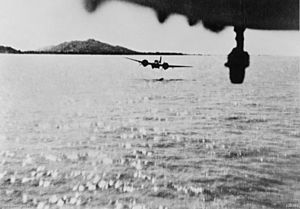
The pilot, Flight Lieutenant William Bowden, survived the crash. He was captured and became the first Allied airman taken prisoner by the Japanese. He was held in a POW camp until September 1945.
By December 24, 1941, the squadron had lost all its planes in battle. The remaining ground crew and some aircrew sailed from Singapore to Burma. They arrived in Rangoon on January 1, 1942. They joined up with No. 113 Squadron and some planes from No. 45 Squadron. Because they didn't have many planes or supplies, the three squadrons often worked together. No. 60 Squadron's aircrews flew planes from No. 113 Squadron. They took part in the first bombing raid on Bangkok and another one later in January.
Operations in India
The squadron had suffered greatly from the Japanese attacks. It was declared non-operational and moved to Asansol, India. There, No. 60 Squadron was given new Blenheim Mk IV planes. On May 22, while returning from a bombing mission to Sitwe, Burma, one of their Blenheims was attacked. It was hit by Nakajima Ki-43 fighters. Flight Sergeant Jock McLuckie, one of the Blenheim's gunners, shot down a Japanese ace pilot, Lt Colonel Tateo Katō.
In March 1943, Richard Campbell Lindsell, an English-Argentinian pilot, became the squadron leader. He had joined the Royal Canadian Air Force and was a very skilled pilot.
In May, the squadron paused operations to get replacement aircraft. By August, they decided to equip the squadron with Hawker Hurricane IIc fighter-bombers. Training started in August in Madras. By November, the Hurricanes were flying escort missions. In January 1944, the squadron began attacking ground targets and supporting troops against the Japanese in Burma.
In one month in 1944, the squadron completed 728 missions! They were praised for how accurately they bombed targets. For his great leadership, Richard Lindsell was awarded the DFC. In May 1945, the Hurricanes were replaced by Republic Thunderbolt fighters.
After World War II
Soon after Japan surrendered, the squadron moved to Java. They quickly became involved in fighting against Indonesian rebels. A year later, No. 60 Squadron moved to Singapore. There, they started flying Supermarine Spitfire F18s. These planes were used to attack Communist guerrillas during the Malayan Emergency. Later, they received de Havilland Vampires in 1950 and then de Havilland Venoms in 1955.
By October 1959, when Gloster Meteor NF.14 night-fighters arrived, the squadron was back at RAF Tengah in Singapore. In July 1961, they switched to Gloster Javelin FAW.9/FAW.9R fighters. They used these until April 1968, when the squadron was closed down.
On February 3, 1969, the Royal Air Force Communications Squadron in Germany was renamed No. 60 Squadron. They started flying older Percival Pembroke transport planes. More modern Hawker Siddeley Andover planes arrived in 1987.
The Pembrokes of No. 60 Squadron were special. They were used for secret spy missions during the Cold War. They often flew along air routes between West Germany and Berlin. These routes were set up during the 1948–49 Berlin Blockade. Even though they looked like regular transport planes, their real job was a secret. They had powerful cameras to take pictures of Soviet and East German military bases. These photos helped experts understand what the opposing forces were doing.
When the Cold War ended, many units in Germany moved. No. 60 Squadron was closed down at Wildenrath on April 1, 1992. But it was reformed just two months later, on June 1, 1992, at RAF Benson in Oxfordshire. This time, they flew Westland Wessex HC.2 helicopters. This period was short, and the squadron was closed again on March 31, 1997.
However, the squadron's name was passed on to the RAF part of the Defence Helicopter Flying School (DHFS) at RAF Shawbury on May 1, 1997. Since April 1, 2018, the squadron has been using the Juno helicopter. They are part of 9 Regiment Army Air Corps and DHFS. Their job is to train pilots and crew members for advanced helicopter flying.
See also
- List of Royal Air Force aircraft squadrons


